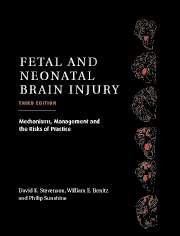Book contents
- Frontmatter
- Contents
- List of contributors
- Foreword
- Preface
- Part I Epidemiology, Pathophysiology, and Pathogenesis of Fetal and Neonatal Brain Injury
- Part II Pregnancy, Labor, and Delivery Complications Causing Brain Injury
- Part III Diagnosis of the Infant with Asphyxia
- Part IV Specific Conditions Associated with Fetal and Neonatal Brain Injury
- 26 Hypoglycemia in the neonate
- 27 Hyperbilirubinemia and kernicterus
- 28 Polycythemia
- 29 Hydrops fetalis
- 30 Acidosis/alkalosis
- 31 Meconium staining and the meconium aspiration syndrome
- 32 Persistent pulmonary hypertension of the newborn
- 33 Pediatric cardiac surgery: relevance to fetal and neonatal brain injury
- Part V Management of the Depressed or Neurologically Dysfunctional Neonate
- Part VI Assessing the Outcome of the Asphyxiated Infant
- Index
- Plate section
30 - Acidosis/alkalosis
from Part IV - Specific Conditions Associated with Fetal and Neonatal Brain Injury
Published online by Cambridge University Press: 10 November 2010
- Frontmatter
- Contents
- List of contributors
- Foreword
- Preface
- Part I Epidemiology, Pathophysiology, and Pathogenesis of Fetal and Neonatal Brain Injury
- Part II Pregnancy, Labor, and Delivery Complications Causing Brain Injury
- Part III Diagnosis of the Infant with Asphyxia
- Part IV Specific Conditions Associated with Fetal and Neonatal Brain Injury
- 26 Hypoglycemia in the neonate
- 27 Hyperbilirubinemia and kernicterus
- 28 Polycythemia
- 29 Hydrops fetalis
- 30 Acidosis/alkalosis
- 31 Meconium staining and the meconium aspiration syndrome
- 32 Persistent pulmonary hypertension of the newborn
- 33 Pediatric cardiac surgery: relevance to fetal and neonatal brain injury
- Part V Management of the Depressed or Neurologically Dysfunctional Neonate
- Part VI Assessing the Outcome of the Asphyxiated Infant
- Index
- Plate section
Summary
Introduction
The pH regulation of the blood is a critical physiologic process necessary to maintain optimum metabolism of body tissues, including the brain. Accordingly, the maintenance of a normal blood pH is of paramount importance for physicians to prevent the untoward effects of acidosis or alkalosis. Respiratory acidosis and alkalosis, as well as metabolic acidosis, are frequently encountered in sick premature and full-term newborn infants. Respiratory acidosis occurs as a consequence of respiratory distress syndrome and other pulmonary disease, while respiratory alkalosis typically occurs as an iatrogenic component of the hyperventilation necessary to oxygenate adequately a critically ill newborn infant. Metabolic acidosis with or without respiratory acidosis typically arises from systemic hypoxia or asphyxia in the fetus or newborn infant. The present chapter will review available information regarding pH regulation of cerebral blood flow (CBF) and metabolism under physiologic conditions and the contribution of acidosis/alkalosis to brain damage, especially that arising from cerebral hypoxia–ischemia.
Effect of respiratory acidosis/alkalosis on cerebral blood flow
Cerebral blood vessels are known to be sensitive to changes in Paco2, such that CBF is increased during respiratory acidosis and decreased during respiratory alkalosis. These CBF responses to changes in Paco2 exist in the fetus and newborn animal, including the newborn infant, although the sensitivity of immature cerebral blood vessels is not as well developed as in the adult. Investigations have been conducted in a variety of animal species, including dogs, pigs, sheep, and monkeys.
- Type
- Chapter
- Information
- Fetal and Neonatal Brain InjuryMechanisms, Management and the Risks of Practice, pp. 593 - 611Publisher: Cambridge University PressPrint publication year: 2003
- 1
- Cited by



